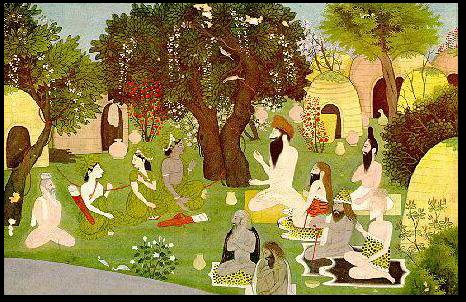Pahari School, Chamba kalam, Kangra idiom
Circa A.D. 1780-1785 Size: 33.1 x 22.7 cm
On being exiled to the forest, Rama, Sita, and Lakshmana, donning garments of bark and grass given to them by Kaikeyi, and with no sign of mental anguish on their faces, left Ayodhya in a chariot with Sumantra. The citizens, out of great love for Rama and unable to bear separation from Him accompanied them on foot. Dasaratha, along with his grieving wives, also went to see once more the face of his beloved Son, but not keeping pace with the fast moving chariot he fell senseless and returned. Rama encamped for the night beside the river Tamsa. The people who had walked during the day were fatigued and still asleep when Rama started his onward journey. They passed through the forest and arrived at the bank of the Ganga, where they passed the night.
In the morning, Rama urged Sumantra to return to Ayodhya with the chariot, advising him that he should act thus in order that the great monarch should not be oppressed by any unpleasant thoughts, and to assure the king that none of them - Rama, Lakshmana, or Sita felt pain or sorrow at having been banished from Ayodhya. Rama asked Sumantra to tell Bharata to look after their mothers without any distinction. The princes, with Sita, crossed the Ganga in a boat provided by Guha, chief of the Nishadas, a tribe living there. Spending one more night in the forest, at sunset they reached the ashrama of Bharadwaja at Paryag (present day Allahabad) at the confluence of the Ganga and Jamuna.
An atmosphere of complete tranquility prevails in the idyllic grove as seen in the painting. The river too, is flowing quietly. Flowering creepers and bushes brighten the scene and two birds are singing. Seven huts are clustered at the right while seven rishis are seated in front of them. Two huts appear at the left where the group is shown seated in a diagonal row, instantly taking the eye towards Rama, who is looking in veneration towards the sage Bharadwaja. Both of them are engaged in a discourse. Rama has kept aside his bow and quiver of
arrows, while these weapons are to be seen on the person of Lakshmana, who throughout the long period of the exile was to remain vigilant to guard Rama and his consort Sita.
The high-soured Maharishi Bharadwaja is a dominating figure like the great tree under which he is seated. Rama narrated the events which had taken place. At this, the sage said that he had already heard of his enforced exile. The noble prince sought the counsel of the sage for selecting a suitable place to pass the fourteen years of his exile. Sage Bharadwaja suggested they should stay with him at the ashram, to which Rama replied that the neighboring people would continue to visit them and thus intrude upon the holy solitude of the hermitage. The sage then suggested they should stay at the Chitrakuta hill at a distance of ten leagues from there, for great saints dwelt there and the holy mount was exceedingly fair, full of fruits, birds, and animals. Thereafter, Rama, Sita, and Lakshmana passed the night in calm repose and at daybreak they moved onwards crossing the Jamuna and the Kalindi until they reached Chitrakuta.
|
